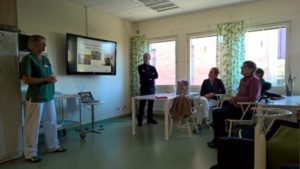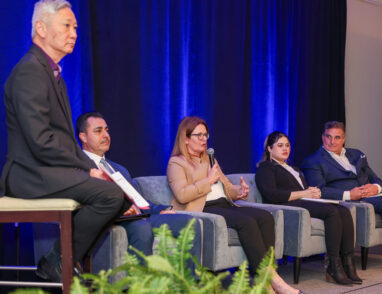Speaking the Same Language in Sweden
April 27, 2016 · Margaret E. O'Kane
I was in Sweden last week, attending the Institute for Health Care Improvement’s annual international conference. It was a huge gathering: more than 3,000 people from around the world, 1,000 of them from Sweden! We heard from people who work across the spectrum of health and social services, and who spoke passionately and convincingly about their commitment to person-centered care, as well to quality improvement. As you might assume, there were many presentations on the Swedish health care system. I was impressed with Sweden’s data and processes—and most especially with its models of long-term, community-based services for the elderly.
So, What Did I Learn?
A lot! I learned that patient-centered care is alive and well in Sweden. We took a field-trip to Jonkoping (pronounced “Jon-shipping”), a city in southern Sweden, to visit the health care center, which includes a hospital and ambulatory clinics. There, we learned about an elder care model called the Esther Project. We also visited a dialysis center where patients run their own dialysis and a neonatal intensive care center where parents can stay with their baby around the clock. The Jonkoping health care center concept of patient engagement has moved to another level. The center allows patients to co-design their care, in fact, and has hired four former patients who serve as mentors, supporters and advisors to current patients.
 Focus on Elder Care
Focus on Elder Care
I was particularly interested in presentations about new models of care for the elderly because NCQA is working in this area. We heard from providers who use a patient-centered concept called “What Matters to Me”; it’s a simple diagram that includes patients’ own words about who they are and what they want to do; for example, “I am a grandfather of a 9-year-old,” “I used to be a plumber,”
“I want to take the bus into town.”
About Registries…
I also went to a very interesting presentation on Swedish registries, where breakthrough collaboratives are organized to address health outcomes. In one example, we saw how a collaborative reduced the hemoglobin A1c of Swedish diabetic children. I really like this model of registry-based, collaborative quality improvement—could it be applicable to NCQA’s work?
Naturally, Not Everything Is Perfect.
On the downside, I saw that divisions between health and social services create problems for patients. Sweden’s privacy laws prevent providers from sharing needed information. When benchmarked against other Organization for Economic Cooperation and Development (OECD) countries, Swedish citizens rate care coordination as fair to poor. Because the system is decentralized, counties and cities often fail to share their successes and learnings.
So, Sweden has opportunities for improvement; I was impressed that these issues were freely discussed, often with “we need to do better on this.”
A “Sister NCQA?”
Meeting and speaking with people from around the world reminded me that health care is a common language and the problems people are trying to solve are universal. One good example hit home when I met the deputy director of New Zealand’s “NCQA,” the Health Quality and Safety Commission, created by government five years ago. It was interesting to hear someone who lives and works almost 9,000 miles away from DC say it’s difficult to hold people accountable for what they cannot control, but that people should be rewarded for doing the right thing and not necessarily for the outcome… however, she added, tracking the outcome is important. Sound familiar?
Final Thoughts…
I came back from this meeting feeling incredibly energized and inspired by what I saw. I think that many of the concepts are useful in our own work for the care of people with complex health needs. And I look forward to learning more about how we might use more registry-based quality improvement.









